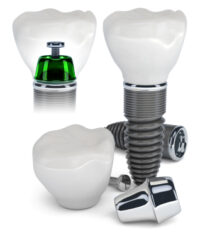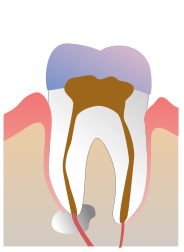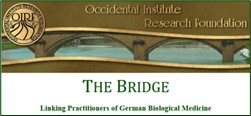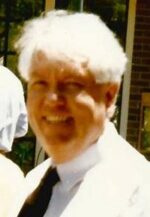Why We Need to Address
the Ground System First,
Before Doing Even More Dentistry
2 Case Histories
Dr. Verigin’s Comment
Last time, we looked at some ways in which conditions in our environment, under the various pressures of climate change, have affected life within it. Pollution isn’t just bad in and of itself but because of the damage it does to the air, soil, animals and humans. And that damage isn’t isolated. Those changes lead to others as life tries to adapt.
In turn, the whole environment becomes changed, less hospitable to life as we know it.
We see a similar dynamic when we look at the human body’s internal environment – the extracellular matrix, the biological terrain.
Seeing Biologically, Seeing the Big Picture
 As cognitive neuroscientist Itiel Dror once noted, “The brain taking shortcuts is one of the cornerstones of human intelligence.” Shortcuts enable the brain to deal with the mismatch between the capacity, the computational power, of the brain, and the need to process some of the information.
As cognitive neuroscientist Itiel Dror once noted, “The brain taking shortcuts is one of the cornerstones of human intelligence.” Shortcuts enable the brain to deal with the mismatch between the capacity, the computational power, of the brain, and the need to process some of the information.
The fact that we have a smaller brain, that we can’t process all the information, has, from an evolutionary perspective, forced the brain to be more sophisticated, to decide what’s important and what’s not important, to have a plan. ‘What am I going to do? What am I going to need for the future?’ This is the core of intelligence: thinking what information is important, not important and so on.
But sometimes, mental shortcuts can lead us astray. You can find one example among some followers of “natural” or “holistic” medicine. The error comes in accepting the same understanding of illness and health as the conventional Western medicine they distrust or reject. Instead of drugs, they’ll take herbs or homeopathics; instead of surgery, acupuncture or other less invasive therapy.
It’s unconventional treatment pursued in a very conventional way – a way that depends on linear, mechanistic thinking.
And that thinking, as we’ve noted, is a real limitation of the conventional model.
This mechanistic thinking also drives the belief (and hope) that if only a chronically ill person could get rid of their mercury fillings – or root canal teeth or cavitations or implants – their health may be restored. But what we repeatedly see in clients with severely compromised health from decades of progressive illness is that dental factors are just one of many physical and energetic burdens on the body, often just triggers to deeper, more ingrained health issues. Some people may tolerate amalgam fillings or root canal teeth for years – just as long as the body is able to effectively excrete the toxins.
But should it fail and toxins accumulate, from dental sources or elsewhere…then you have problems.
When we analyze a client’s biological terrain, current dental conditions and complete health history, we typically see burdens building from a very young age and accumulating over time. “Simple” and “easy” health complaints are treated with drugs, which add to the burden and often generate more symptoms “requiring” more treatment. The illness progresses into deeper and deeper phases. Eventually, the person may turn to non-allopathic therapies, but if they’re used in the same mechanistic way, positive results tend to be short term.
 Symptoms and illnesses don’t just happen. They happen for reasons. There is an action and then a reaction. It’s the universal law by which everything functions. In regard to health, the actions are the wrong things we do (epigenetics) that jeopardize our well-being. Symptoms, infections and degenerative diseases are the reaction.
Symptoms and illnesses don’t just happen. They happen for reasons. There is an action and then a reaction. It’s the universal law by which everything functions. In regard to health, the actions are the wrong things we do (epigenetics) that jeopardize our well-being. Symptoms, infections and degenerative diseases are the reaction.
In German Biological Dental Medicine, it is a crucial constitutional epiphany that when you focus on a reaction instead of the actions that caused it – when you focus on the effect instead of the cause – then you are putting yourself into a defensive position. I call it “after-the-fact treatment.” It means you’re already in an adverse predicament with your health, and it’s sometimes too late to counteract with effective therapeutics.
That’s a hard truth. But it is truth.
“The straw that broke the camel’s back” is a fitting idiom here. It highlights how a seemingly minor action can cause a sudden and unpredictably large reaction.
Symptoms are nothing less than the result of prolonged abuse and neglect of our bodies. Trying to fight them is like rushing to save your belongings when the ship you were sailing on is already under water. For healing to happen, the body’s self-regulating mechanisms first must be stimulated. You have to spur its innate clearing and healing ability so it can finally begin excreting the accumulated toxins. Once you do, other interventions – cavitational surgery, say, or mercury removal – should prove more successful.
Going this route requires a change in thinking – a willingness to go beyond simplistic explanations and superficial gestures toward cure. It requires expansive thinking and acceptance of the dynamism that life, by definition, is.
You’ve got to look at the big picture.
Always!
To do so, let’s take a look at a couple of typical cases that have presented to our office over the past year.
Case History #1: Jane
 Jane, age 54, made an appointment for an exam and consult about a pair of titanium dental implants that had been placed in her lower left jaw about 18 months earlier.
Jane, age 54, made an appointment for an exam and consult about a pair of titanium dental implants that had been placed in her lower left jaw about 18 months earlier.
She presented with some significant medical issues. Most annoying and distressing to her were the numerous skin lesions evident on her lower legs and arms. She admitted to smoking 20 to 30 cigarettes a day, having smoked since she was 14 years old. She’d had genital herpes since her late teens and bouts of genital candida overgrowths. She admitted to being allergic to gluten and spring blooms, including grasses.
Her clinical dental exam showed 7 teeth with mercury amalgam fillings, 18 surfaces total. All third molars (wisdom teeth) had been extracted, along with the two lower molars on the left. That site was where the implants now were, with porcelain-fused-to-silver crowns capping them. The clinical quality of the work was what dental school instructors or state boards would consider standard.
During our consultation, Jane said she was convinced that her health had been satisfactory, mainly to her liking. She strongly believed the titanium implants may have led to the development of her unsightly skin lesions. She asked me to refer her to the oral surgeon I use so she could have the implants removed.
I asked her to tell me more about the history of those sores. She said they had started to show up about 7 or 8 months earlier. She consulted a dermatologist who diagnosed the lesions as a form of eczema or plaque psoriasis – an autoimmune condition. He prescribed a prednisone cream. It didn’t help.
Another dermatologist she saw suggested oral prednisone instead. That didn’t work either. Meantime, the lesions had grown to about the size of 25-cent pieces.
Yet another physician thought the lesions might be caused by a staph or strep infection. He diagnosed them as MRSA-like, but biopsies generally pointed to psoriasis.
A fourth physician even thought it might be a pulmonary sarcoidosis associated with psoriasis and had a chest x-ray done. The results ruled out that diagnosis.
My initial opinion was that the implants could have initiated heavy stress on her greater defense system. The 8 to 9 months of latency between the placement of the implants and the appearance of the lesions could well have ignited their development.
Major interventions like the placement of titanium dental implants should not be undertaken without ensuring that the extracellular matrix and ground regulation have been properly and adequately assessed via Biological Terrain Assessment (BTA).
In other words, the success of any invasive oral surgery depends on properly preparing proper conditions for a healthy, uneventful healing response.
Often, the surgeon doing the implants doesn’t recognize that the sites of placement are already disturbance fields with distant effects. This was shown by Kellner in 1979 and Perger in 1990. These areas of chronic foci – cavitations (a/k/a ischemic bone disease or chronic jaw osteitis) –cause energy-consuming limitations and tissue acidosis, with increased depletion of bone forming osteoblasts. Perger called this an exhaustion of regulatory output. A focal disease, he taught, is a disease of regulation.
Patients with foci due to an existing cavitation are already overloaded by previous surgical stress. Often, another surgical entry to that site will cause a more serious disruption of Ground Regulation and a shock to progressive forms of autoimmune diseases.
If you then surgically remove the implants without improving the patient’s regulatory capacity, a series of progressive shock will develop. Issuing another shock so soon is apt to impair the patient’s immune cycle. It can no longer respond adequately to yet more surgical stress. Theoretically, this could provoke another more serious illness (toxicosis) such as MS or cancer.
In a case like Jane’s, I would not attempt to do anything before making a thorough assessment of the biological terrain and addressing her regulatory issues. Only after success in that area would implant removal make any sense.
Case Study #2: John
 Twelve years ago, John – then age 60 – came to our office after reading about us online. He would be working in our area for several weeks and wanted to see about having all of his mercury amalgam fillings removed. He had several root canal filed teeth, as well. All third molars had been removed due to past infections.
Twelve years ago, John – then age 60 – came to our office after reading about us online. He would be working in our area for several weeks and wanted to see about having all of his mercury amalgam fillings removed. He had several root canal filed teeth, as well. All third molars had been removed due to past infections.
After taking a full set of x-rays and performing a clinical examination, we discussed the risks, benefits, pros and cons of removing the fillings and root canals.
It was two years later before I saw him again. He was again working in the area and wanted another consultation. This time, he came with a bag full of books that he’d studied to learn more about his dental concerns. There were books by Hal Huggins, Patrick Störtebecker, Steven Green, George Meinig, Robert Kulacz, and more, as well as articles by Chris Hussar, Dietrich Klinghardt and others. It was like a Who’s Who of biological and integrative dental medicine.
We had a good discussion, but again, I didn’t hear further from him until spring of 2015, when he asked if I would evaluate him using Biofunctional Regulation Assessment According to German Theory.
This time he was in a wheelchair. He said he’d been diagnosed with a lymphoma-like cancer and multiple sclerosis about 5 or 6 years earlier at a major west coast university. They told him that the cancer was so bad and his prognosis so poor, he should just go home and get his affairs in order. Instead, he started working with a naturopath. John said they had made a lot of progress, but then they’d reached a plateau and couldn’t break through.
The naturopath wanted to know if John’s earlier oral surgery down in Mexico had been successful, if it had resolved his chronic jaw cavitations.
After getting a full mouth set of x-rays and doing a clinical exam, I found he had no upper teeth. With the exception of the teeth between his two first bicuspids, all lower teeth had been removed, as well. He had just 8 teeth left – one quarter of the full adult complement.
Using both Voll and Kramer Bio Resonance technique, I found only 6 extraction sites that were free of cavitations. All the others had suspected cavitations graded from medium to very high energetic disturbances.
John said that the Mexican clinic had performed his surgeries over just two days. Other than the usual post-op pain and discomfort, he had no medical or dental complaints. He was fitted with a full upper denture and a lower partial.
About three years later, he began experiencing some serious medical symptoms but no dental symptoms. Within the next couple years, he developed the lymphatic cancer and MS.
My opinion is that the severe surgical shock that he received from those two days of invasive surgery in Mexico perfectly illustrate what Kellner and Perger had shown in their research. The shock caused a more serious blockage of his Ground Regulation and more progressive forms of autoimmune diseases – all because the surgeons failed to thoroughly assess the patient’s extracellular matrix and Ground System Regulation to determine if John could handle the shock of surgery.
The outcome speaks for itself.
Next time, we’ll take a look at how better outcomes are possible. And they are possible.
Parts of this article are freely adapted from “Not Just the Mercury Fillings or Just the Root Canals or Implants or Cavitations,” originally published on Dr. Verigin’s office blog, Know Thy Health, January 14, 2013.
 A Reprinted Article for OIRF Supporters
A Reprinted Article for OIRF Supporters
From THE BRIDGE Newsletter of OIRF
Published February 2016
From Biosis: Integrated Health Solutions
From the Office of Gary M. Verigin
Issue #50, Spring 2016
© Copyright 2013, 2016, Dr. Gary Verigin, California, USA



